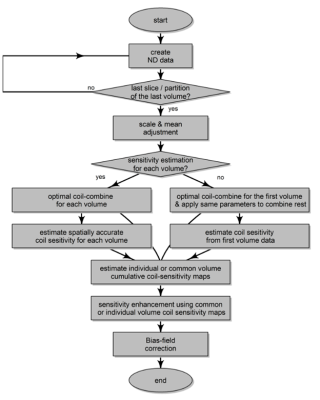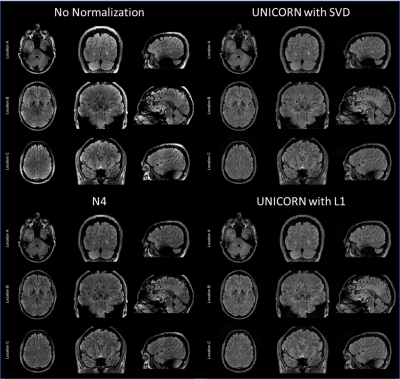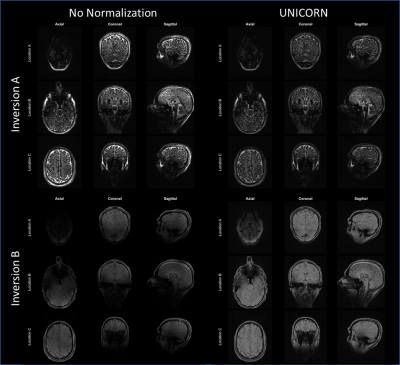2609
Uniform Combined Reconstruction for Improving Receive Intensity Homogeneity of N-dimensional 7T MRI1Siemens Medical Solutions USA, Inc., Rochester, MN, United States, 2Siemens Medical Solutions USA, Inc., Los Angeles, CA, United States, 3Siemens Healthcare GmbH, Erlangen, Germany
Synopsis
Uniform combined reconstruction (UNICORN) was recently proposed and used to improve receive uniformity of 7T musculoskeletal and brain MRI data from two-dimensional (2D) sequences. In this work, we extend the UNICORN algorithm to improve receive uniformity of two-, three-, or more-dimensional (N-dimensional or ND) MRI. We also demonstrate UNICORN results using L1-based (computationally efficient compared to singular value decomposition or SVD) optimal combination of the multi-channel data and compare the results with the previously used SVD-based combination.
Introduction
Receive inhomogeneity impacts MR image intensity uniformity at high and ultra-high field. Uniform combined reconstruction (UNICORN) was recently proposed (1, 2) and used to improve receive uniformity of 7T musculoskeletal (1–4) and brain (5) MRI data from two-dimensional (2D) sequences. In this work, we extend the UNICORN algorithm to improve receive uniformity of two-, three-, or more-dimensional (N-dimensional or ND) MRI. Previous work (1, 2) used singular value decomposition (SVD) for optimal combination of multi-channel data. SVD is computationally intensive, especially for large ND data sets. In this work, we also demonstrate UNICORN results using L1-based (computationally efficient compared to SVD) optimal combination of the multi-channel data and compare the results with SVD-based combination.Methods
ImagingTwo subjects were imaged at 7T (MAGNETOM Terra, Siemens Healthcare, Erlangen, Germany) under the guidelines of an institutional review board. Imaging was performed using a single-channel transmit, 32-channel phased-array receive head coil (Nova Medical Inc., MA, USA). MP2RAGE (6) sequence was used to create a 4D data set (two 3D volumes, each at a different inversion time). Turbo spin-echo (TSE) sequence was used to create multiple slices (2D) of a dark-fluid brain MRI volume.
UNICORN ND
Figure 1 shows the flowchart of the proposed UNICORN ND algorithm. The steps of the algorithm are:
- Create ND data using the multi-channel and slice/partition information from all the imaging volumes (3 spatial dimensions, 1 coil dimension, and any additional contrast and/or time dimensions etc.).
- Optimize the scale and mean of the individual channel data.
- Estimate the optimal coil/channel combination parameters based on the first volume or each of the individual volumes per user selection.
- Estimate individual coil sensitivity from the first volume or from each of the individual volumes.
- Compute cumulative coil sensitivity from the first volume or from each of the individual volumes.
- Enhance the sensitivity of the algorithm using cumulative coil sensitivity estimated from each individual volume or from the first volume.
- Apply bias-field correction.
Results
Figure 2 shows the improvement in uniformity achieved by SVD- and L1-based UNICORN algorithm on the dark-fluid TSE 7T brain MRI data. A comparison with N4-based normalization is also shown. UNICORN options reduced the hyper-intensity near the surface of the brain. Additionally, UNICORN improved intensity and uniformity in the interior regions of the brain relatively better than the N4 normalization method.Figure 3 shows the improvement in uniformity achieved by the UNICORN ND algorithm at 7T on the two inversion volumes from the 4D MP2RAGE data set. L1-based coil combination was used by the UNICORN algorithm for images shown in Figure 3. UNICORN reduced the hyper-intensity near the surface of the brain and improved the conspicuity of the inferior regions of the brain.
Discussion
This work demonstrates preliminary results from the application of UNICORN ND algorithm on sequences generating more than a single volume. When multiple volumes are generated from a sequence, the coil sensitivity estimated from the first volume could be used for the rest of the imaging volumes. However, motion during imaging could reduce the accuracy of spatial registration of the sensitivity map from one volume used for other volumes. In this work, coil sensitivity was estimated for each volume individually.An initial result from a computationally efficient (L1) alternative to SVD-based coil combination is also shown. Results from L1-based coil combination were found to improve uniformity with similar performance as images from SVD-based coil combination.
Receive and transmit non-uniformity is often observed at 7T. UNICORN was developed to reduce the receive-induced non-uniformity without use of a reference scan. Future work would analyze the utility of UNICORN to improve intensity homogeneity at 7T in combination with transmit non-uniformity correction methods.
Conclusion
The UNICORN ND algorithm has potential to reduce receive inhomogeneity of ND MRI at 7T.Acknowledgements
No acknowledgement found.References
1. Chebrolu VV, Kollasch PD, Deshpande V, et al.: Uniform combined reconstruction of multichannel 7T knee MRI receive coil data without the use of a reference scan. J Magn Reson Imaging 2019; 50:1534–1544.
2. Chebrolu VV nadh, Kollasch P, Deshpande V, et al.: Uniform Combined Reconstruction (UNICORN) of Multi-channel Surface-coil Data at 7T without use of a Reference Scan. In Proc Jt Annu Meet ISMRM-ESMRMB Paris, Fr; 2018:5174.
3. Chebrolu VV, Kollasch P, Deshpande V, et al.: Evaluation of the Uniform Combined Reconstruction (UNICORN) Algorithm for Improving 7T Knee MRI Uniformity. In Proc 27th Sci Meet Int Soc Magn Reson Med. Montréal, QC, Canada; 2019:4506.
4. Chebrolu VV, Sommer S, Deuster C von, Galley J: Improving 7T Cervical Spine (C-spine) MRI using the Uniform Combined Reconstruction (UNICORN) Algorithm. In ISMRM SMRT Virtual Conf; 2020:3410.
5. Chebrolu VVN, Seethamraju R, Stinson EG, Mihai G, Kimbrell V, Mukundan S: Qualitative and Quantitative Evaluation of Uniform Combined Reconstruction (UNICORN) for Improving Intensity Uniformity in 7T-MRI of the Brain. In ISMRM SMRT Virtual Conf; 2020:2000.
6. Marques JP, Kober T, Krueger G, van der Zwaag W, Van de Moortele PF, Gruetter R: MP2RAGE, a self bias-field corrected sequence for improved segmentation and T1-mapping at high field. Neuroimage 2010.
7. Tustison NJ, Cook PA, Gee JC: N4ITK: Improved N3 Bias Correction. IEEE Trans Med Imaging 2010; 29:1310–1320.
Figures


